Hydrogeological situation on 1 January 2024
In December 2023, groundwater recharging continued, with an increase in levels at 69% of the observation points. Only the aquifers along the Mediterranean coast and in Corsica had stable or lower levels.
The general situation continued to improve: 56% of the levels were above monthly averages in December (as opposed to 48% in November). The state of the aquifers was very satisfactory over much of France, due to abundant rainfall at the beginning of the recharge period. It was less favourable, with moderately low to low levels, in the inertial aquifers in the Sundgau area and Saône corridor and in the aquifers along the Mediterranean coast.
Trends and changes during winter will depend primarily on rainfall. This initial winter recharge period means we can expect satisfactory levels at the end of winter, for much of France. However, if there is not enough rainfall, the depletion could resume and rapidly deteriorate the state of the reactive aquifers and more slowly that of the inertial aquifers. The state of the aquifers along the Mediterranean coast will need to be closely monitored as they have been weakened by severe low-water levels and the lack of any significant recharge events.
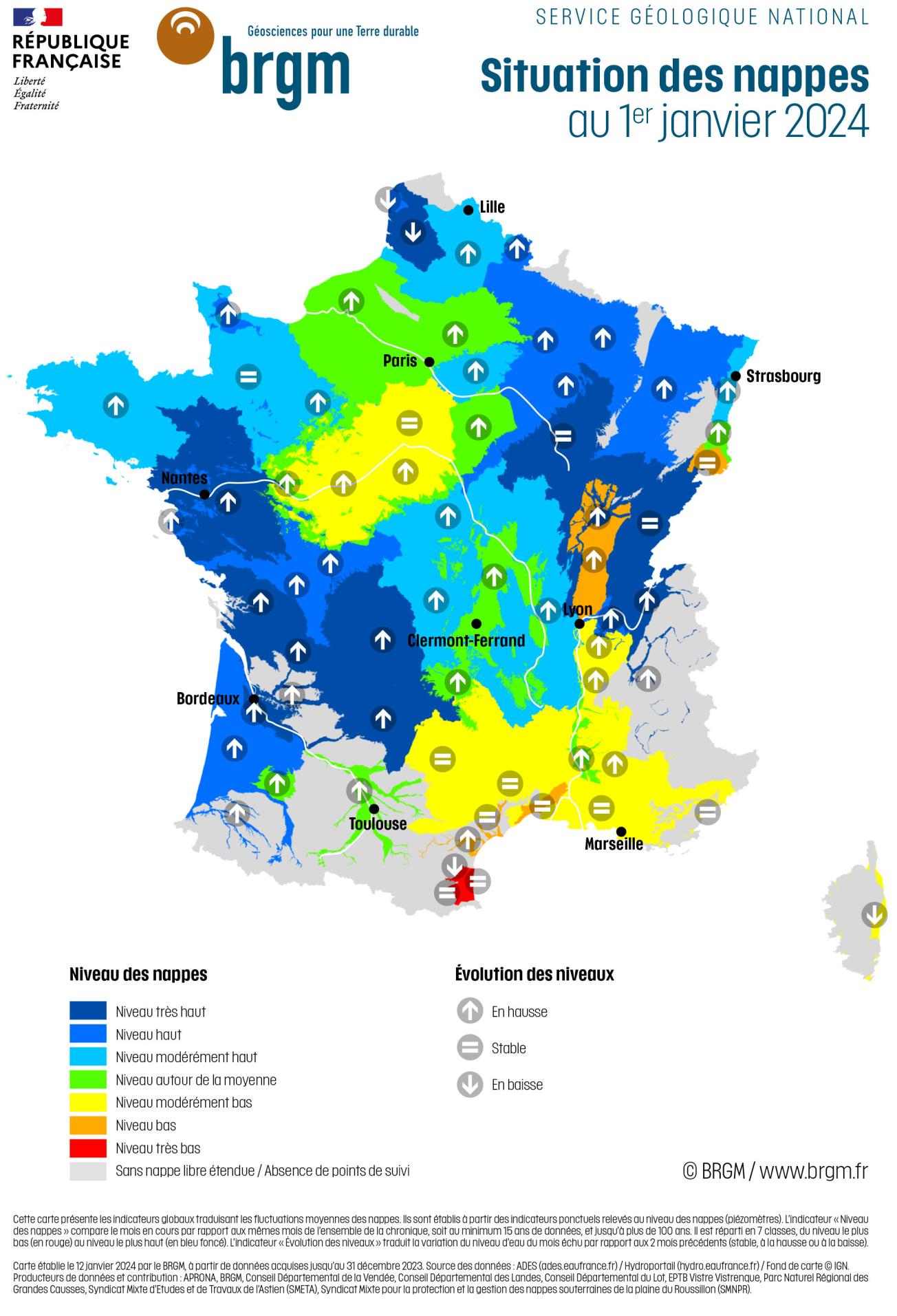
Map of aquifer levels in mainland France on 1 January 2024.
© BRGM
Groundwater trends
The recharge period usually begins with the storms at the end of August and September for reactive aquifers and between October and November for inertial aquifers. In 2023, groundwater depletion continued, due to insufficient rainfall and the fact that the vegetation remained active at the onset of autumn due to high temperatures. Following the rainfall that began in mid-October and continued into November, the aquifers began to recharge between the end of October and the end of November.
In December 2023, aquifer recharging continued for much of France. Levels were up at 69% of the observation points (as opposed to 78% in November).
The levels of most inertial and reactive aquifers were higher in December 2023, as a result of the deep infiltration of autumn and early winter rainfall. This phenomenon is due to a monthly recharge that exceeds in volume the natural draining of the aquifers towards their outlets (springs, rivers and streams, the sea, etc.).
The lower or stable levels observed in some sectors can be explained by a number of key factors. The levels at some observation points were found to be stable in December, in the inertial aquifers of the Paris Basin, particularly in northern Beauce and Sundgau (southern Alsace). The high inertia of these aquifers means that rainfall takes several weeks to infiltrate; during December, the trends slowly reversed and levels were stable overall. After rapid rises in levels in November, the levels in aquifers along the Pas-de-Calais coast began to drop in December, before rising again at the end of the month. Finally, the aquifers along the Mediterranean coast did not receive sufficient rainfall in December. Recharging still did not appear to have begun in the aquifers of the Roussillon plain and the Corbières massif.
Comparison between 1 January 2023 and 1 January 2024
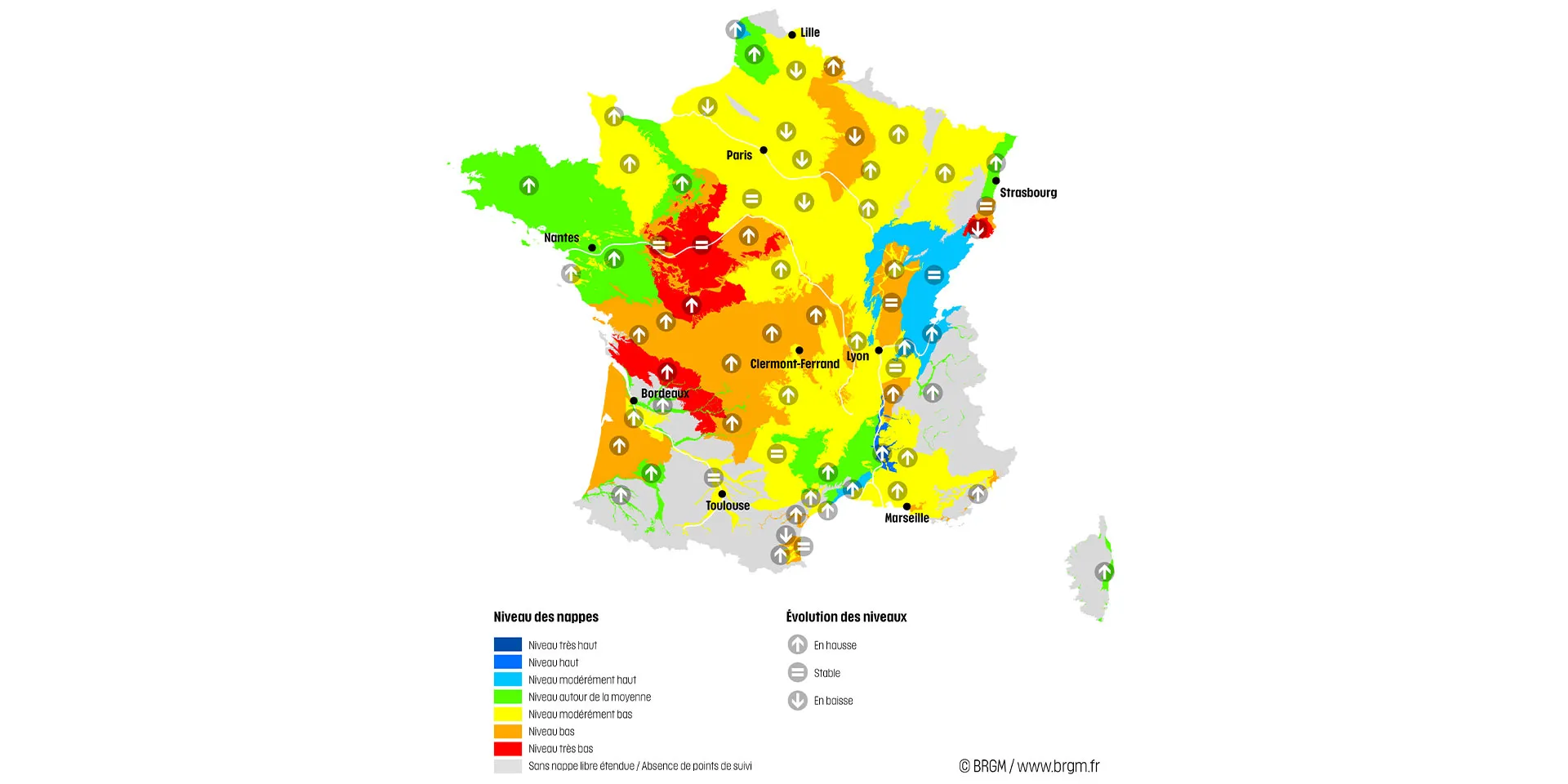
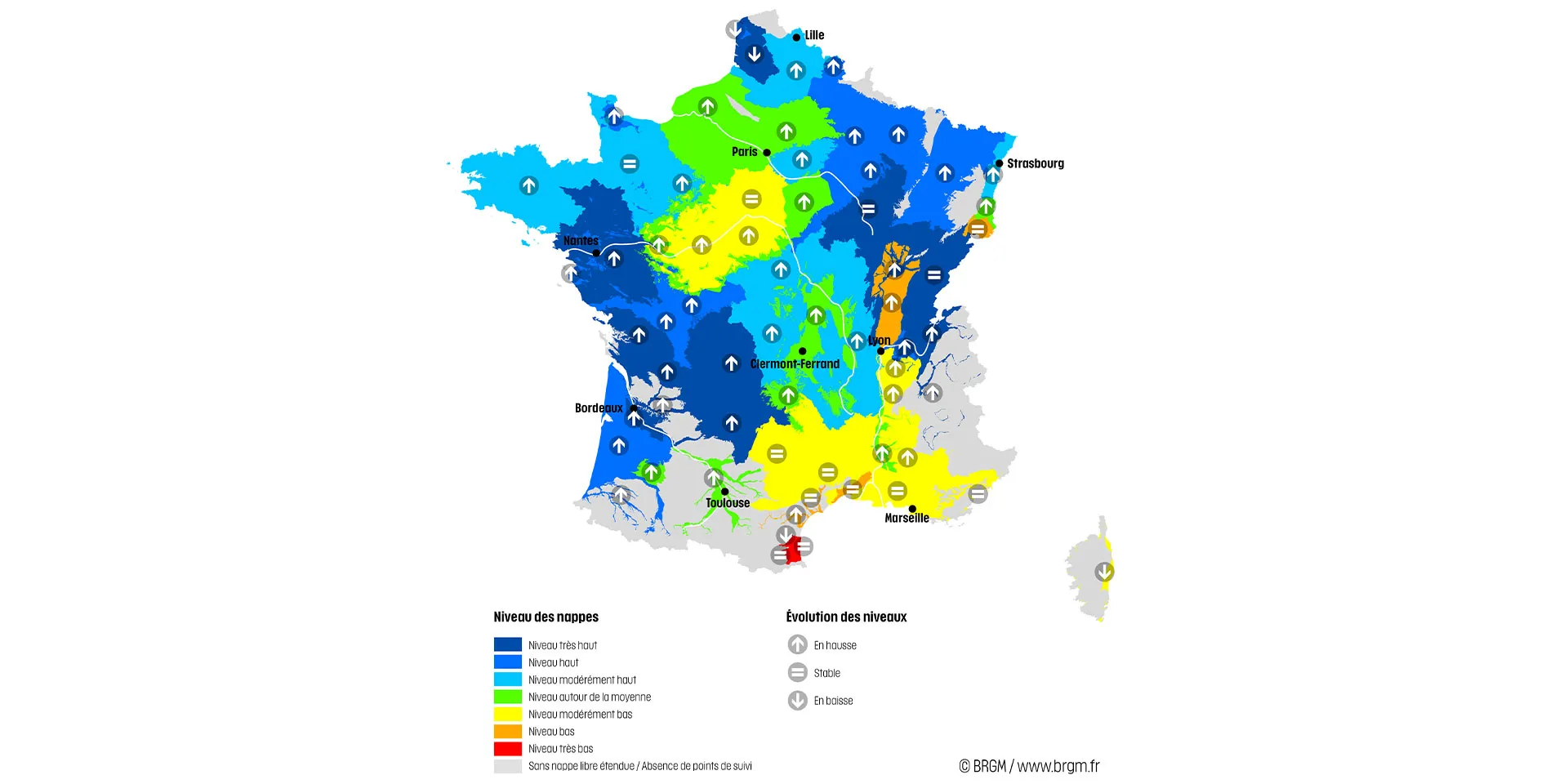
Map of France showing the state of the aquifers on 1 January 2023 (left) and 1 January 2024 (right).
© BRGM
The groundwater situation
The groundwater situation during the low-water period in 2023 was unsatisfactory, with aquifer levels being generally below normal monthly levels. Subsequently, the rain that fell in the second half of October and in November had a significant effect on the state of the aquifers. The general situation improved considerably in November, particularly for the reactive aquifers.
In December, the situation continued to improve, albeit more gradually: The levels recorded at 36% of the observation points were below monthly averages, 8% were comparable and 56% were above (respectively 41%, 11% and 48% in November). The situation was more positive than that observed for the previous year, in December 2022, when 72% of the levels recorded were below monthly averages. Only the Languedoc, Roussillon and Corsica aquifers had levels that were lower than at the end of 2022.
The state of aquifers in December 2023 varied greatly, ranging from very low to very high levels.
In the northern two-thirds and south-west of the country, the situation is very satisfactory in the middle of this recharge period. Rainfall that has infiltrated since mid-October has been very beneficial. In detail, the levels of the reactive aquifers remain very satisfactory, generally from moderately high to very high. Some of the very high levels in the alluvial aquifers are probably due to floods in the rivers and streams. The flood waves may have propagated through the alluvial aquifers. As regards mixed to inertial aquifers, the situation is improving slowly. The state of aquifers is favourable in the north of France (Artois, north of the Paris Basin, Lorraine and the Alsace plain), under the Limagne plain and around the Auvergne volcanoes, and in the Savoie foothills. Very high aquifer levels have been recorded on the Artois coast and in the Savoie foothills, following major recharge events in recent weeks. The situation remains below normal for the inertial to mixed aquifers south of the Paris Basin (Touraine and Beauce), the Sundgau (southern Alsace) and the Saône, mid and downstream Rhône corridor.
In the south of the Massif Central, the edge of the Cévennes range, around the Mediterranean and in Corsica, aquifer levels changed very little due to low rainfall, and generally remained below normal monthly levels. Recharge episodes were recorded during the first half of December in the Provence, Durance and eastern Côte d'Azur aquifers, but they were still insufficient to improve their state. Levels remain a cause for concern in the aquifers of Roussillon, the limestone aquifers of the Corbières massif and the alluvial aquifers along the Languedoc coast.
Aquifers that are in a very good state
Several aquifers were found to be in a very good state, with levels being high to very high in relation to the levels recorded for December in previous years:
- The high levels in the Jurassic limestone aquifers of the Boulogne region and in the Cenomanian chalk marl aquifers along the Artois-Picardie coast are due to a very high 2022-2023 recharge surplus and exceptional rainfall at the end of October and in November 2023;
- The aquifers in the south-west – the southern basement of the Armorican Massif and the western Massif Central, the Jurassic and Cretaceous limestone aquifers, those in the Tertiary and Plioquaternary formations of the Aquitaine Basin and the alluvial aquifers of the lower Garonne, the Dordogne, the Adour and the Gave de Pau – benefited from abundant rainfall from mid-October to mid-November;
- The state of the Champagne and Lorraine aquifers improved again in December and levels were high;
- The alluvial aquifers of the Rhône, Saône and Alpine massif and the Jurassic aquifers of the Jura were immediately affected by the excess rainfall since mid-October. Levels continued to improve in December and are now very high.
Aquifers that are in a poor state
Many aquifers were in a poor state, with low to very low levels compared to those recorded in December of previous years, owing to an extreme rainfall deficit over the last few months or years:
- The situation is improving very slowly in the plioquaternary gravel inertial aquifers of the Sundgau and the Dijonnais, Bresse and Dombes regions, but their levels are low due to several successive winter recharge deficits and also to their very inertial characteristics;
- Aquifer levels in the Villafranche formations of the Vistrenque and the alluvial deposits of the Hérault, Orb and Aude rivers are low, with too little rainfall to generate significant recharge events;
- The state of the aquifers in the Roussillon multi-layer formation and the karst limestone of the Corbières massif remains extremely poor, with very low levels, as a result of a lack of rainfall for more than a year.
How do aquifers fill up and how do they empty?
Groundwater levels vary throughout the year, from high levels in winter (when vegetation does not absorb rainwater) to low levels in summer (the traditional depletion period).
The fate of rainfall varies greatly depending on the time of year and the condition of the ground surface on which it falls. Usually, the groundwater-recharge period takes place from early autumn (September-October) to early spring (March-April), a six-month period during which vegetation is dormant (with low evapotranspiration) and rainfall is generally more abundant. If the winter is dry, groundwater recharge is very low.
From spring through summer, rising temperatures coupled with the regrowth of vegetation and thus increased evapotranspiration, limit the infiltration of rainfall into aquifers. Between May and October, unless there are exceptional rainfall episodes, aquifer depletion usually continues and levels will keep decreasing until the autumn.
Why do some aquifers recharge faster than others?
Groundwater flows at different rates depending on the porosity (percentage of gaps/cracks in the rock) and permeability (capacity to allow water to circulate, i.e. interconnectivity between these gaps/cracks) of the aquifers. The larger the gaps and the more interconnected they are, the faster the water will flow, for both refilling and depletion.
It takes a given volume of water different periods of time to travel the same distance, depending on the kind of rock formation:
- a few years in a porous formation,
- a few months in a cracked formation,
- and a few days, or even a few hours, in a karst formation.
Inertial and reactive aquifers: what are they?
The impact of the winter recharge varies according to the cyclic nature of the aquifer, i.e., its reactivity to rainfall infiltration.
We refer to aquifers that are:
- reactive (when they are composed of sand, gravel, karst limestone or weathered granite formations). These aquifers are characterised by their rapid reaction times: they can recharge during heavy summer rainfall, but are also highly sensitive to drought. Their levels can therefore vary very quickly over the course of the same season.
- inertial (when composed of chalk, non-karst limestone, sandstone formations). Their reaction times are slow. They can have multi-annual cycles, meaning that they require a long period to recharge or empty.

Cyclicity of aquifers in mainland France.
© BRGM
Forecasts
The seasonal forecasts from Météo-France for the months of January, February and March 2024 predict higher temperatures across the country and wetter-than-normal conditions in a large part of northern France. No clear scenario has been established concerning rainfall along the Mediterranean coast.
The trends and therefore the evolution of the state of the aquifers until spring and the resumption of vegetation growth will depend exclusively on accumulated rainfall. If there is insufficient precipitation, the infiltrated rain will not compensate for the output volumes (through natural outlets and abstractions). Levels will then be stable or falling and the situation will deteriorate. Only inertial-aquifer levels could continue to rise, due to the slow infiltration of rainfall. Alternatively, if there is enough rainfall the recharging will continue. The state of the aquifers will then improve rapidly in areas which received rainfall and that have reactive aquifers, and more slowly in the inertial aquifers.
Given the rainfall recorded in the first dekad of January 2024 and the forecasts up to the end of the month, recharging should continue in January over much of the north of France. The state of the aquifers should improve, notably in areas that benefit from sustained recharge events. If enough rainfall accumulates, the most reactive aquifers (basement, karst limestone, alluvial) could experience sharp rises in water levels. Reactive aquifers should remain above normal monthly levels. In the inertial aquifers, the situation should evolve slowly.
As for the aquifers along the Mediterranean coast, the rainfall totals observed and expected in January are unlikely to generate significant recharge events, so their levels are likely to remain below normal.
Over the next quarter, levels in the inertial aquifers of the Artois Basin, the Paris Basin and the Rhône-Saône corridor should continue to rise, with the slow infiltration of rainfall. The state of the aquifers should thus continue to improve. Normal to surplus rainfall until spring should allow close-to-normal levels in many of the inertial aquifers. The forecasts are more pessimistic for the Plioquaternary aquifers of Sundgau and Dijon, Bresse and Dombes, unless there is very high rainfall over the coming months. Levels in these aquifers are expected to remain below normal monthly levels, due to very low levels during the low-water period of 2023 and the significant inertia of the aquifers.
In the case of reactive aquifers, the forecast is not clear for the next few weeks and will depend on accumulated rainfall. Over a large part of the north and south-west of the country, the start of the winter recharge means that we can expect satisfactory levels at the end of winter. However, the situation could also deteriorate rapidly if there is insufficient rainfall, and levels in the spring of 2024 could then be below normal. Levels in the summer of 2024 will depend on whether there is abundant recharge during the winter that continues into the spring, which could then postpone the start of the depletion period.
As for the aquifers along the Mediterranean coast, a return to above-normal levels by the end of winter 2023-2024 is possible, if there are significant, well-distributed rainfall events over the coming months. However, it would appear difficult to envisage any lasting replenishment of the reserves in the Roussillon aquifers and above-normal levels by the spring of 2024.
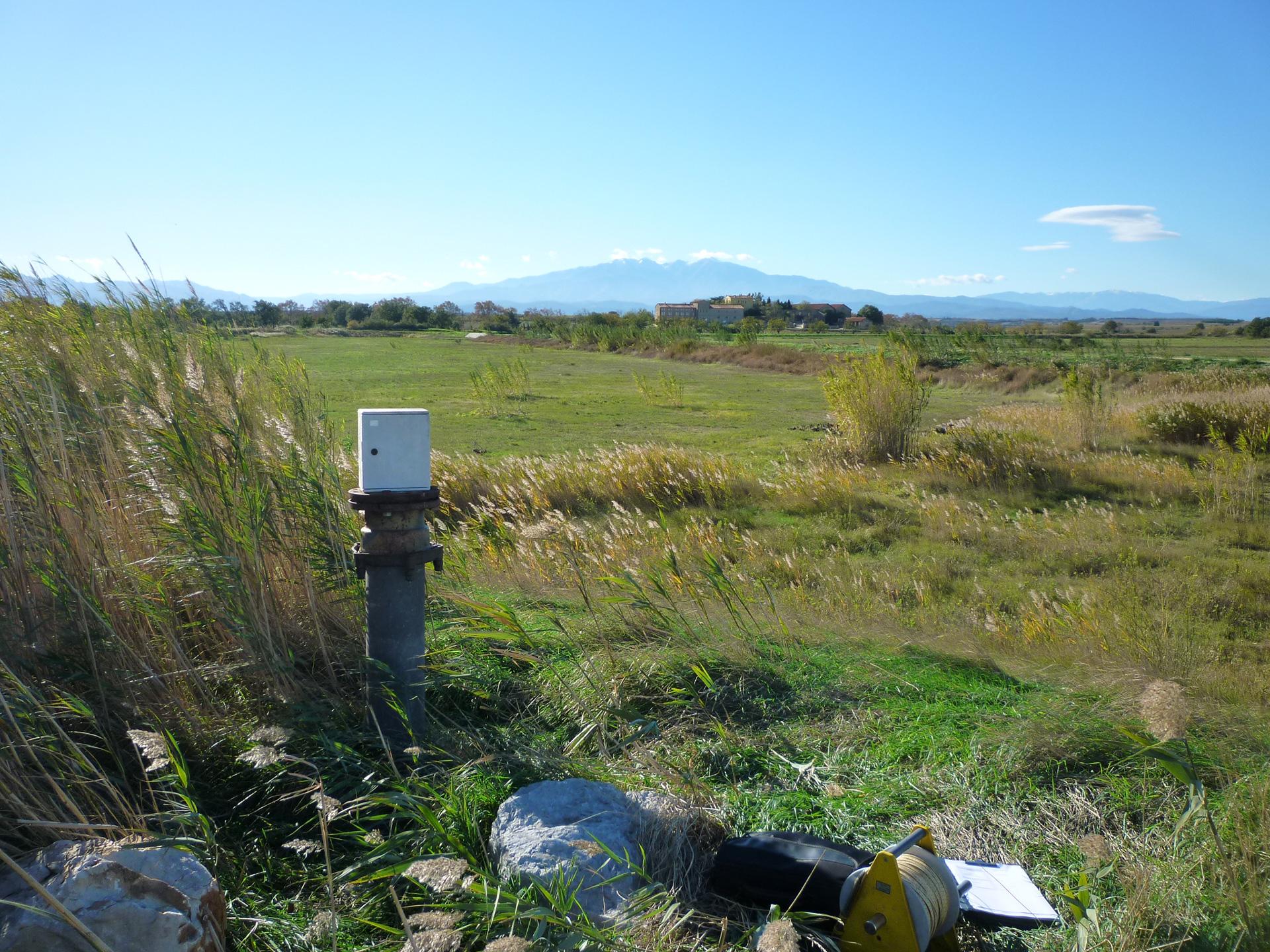
State of groundwater: monitoring by BRGM
Groundwater is a widely used resource: in metropolitan France, it accounts for nearly two-thirds of drinking water consumption and more than one-third of agricultural water consumption. It is also widely used in the industrial sector. Groundwater tables depend on cyclical recharges.
BRGM monitors groundwater levels and quality in mainland France. Discover the actions carried out by the French geological survey and the resources and databases available on groundwater in France.
Press contact


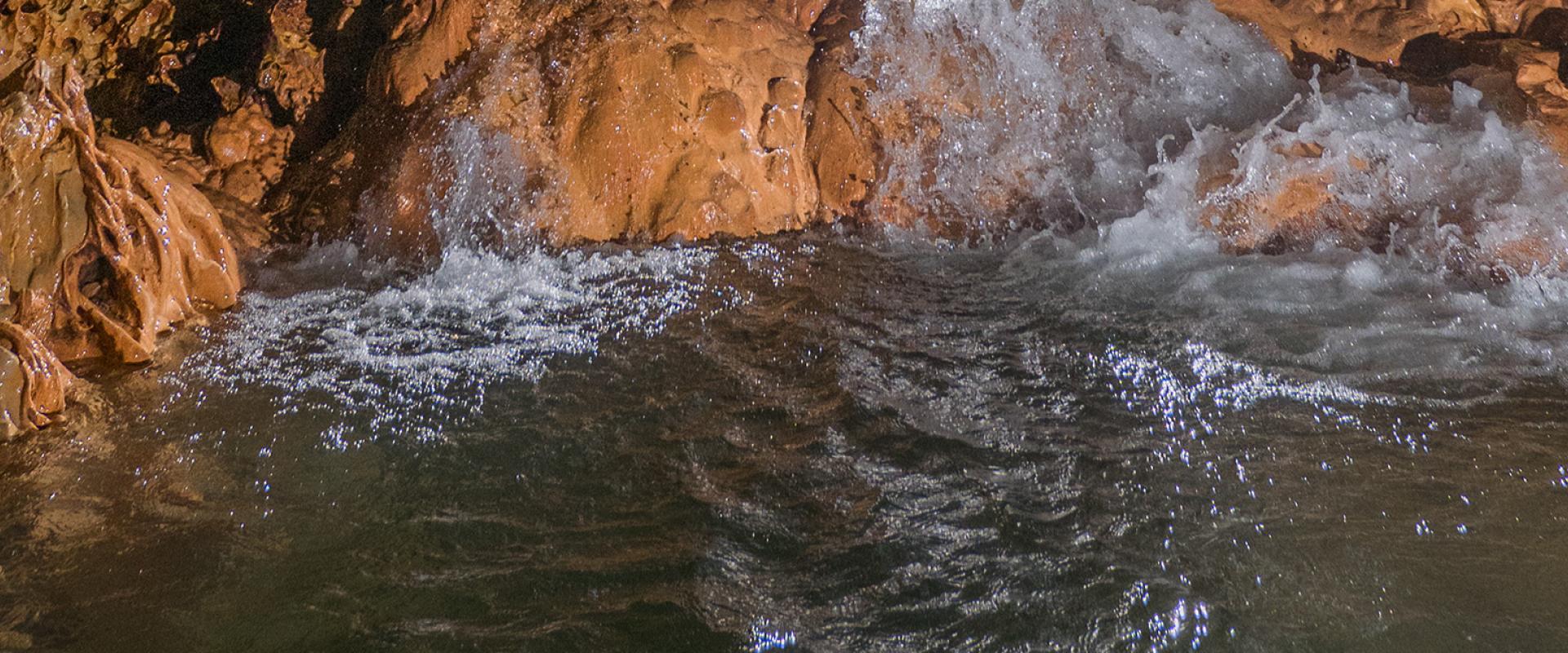
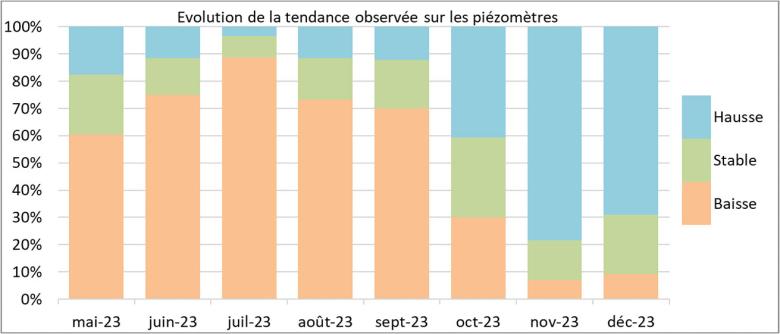
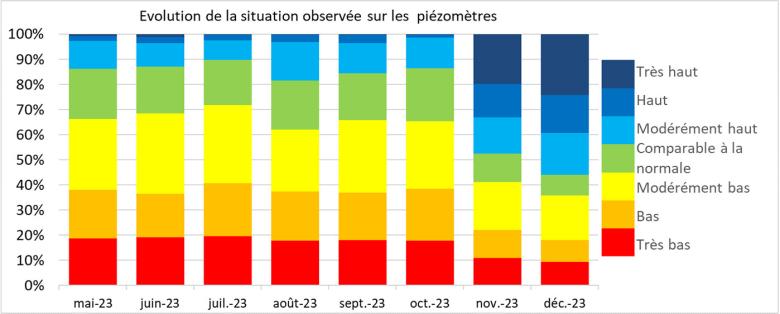




Map drawn up by BRGM on 12 December 2023, based on data from the ADES database, acquired up to 31 December 2023. Data source: ADES database (ades.eaufrance.fr) / Hydroportail (hydro.eaufrance.fr) / Background map © IGN. Data producers and contributors: APRONA, BRGM, Conseil Départemental de la Vendée, Conseil Départemental des Landes, Conseil Départemental du Lot, EPTB Vistre Vistrenque, Parc Naturel Régional des Grandes Causses, Syndicat Mixte d'Etudes et de Travaux de l'Astien (SMETA), Syndicat Mixte pour la protection et la gestion des nappes souterraines de la plaine du Roussillon (SMNPR).
This map shows the global indicators reflecting the average fluctuations of the aquifers. They are based on point indicators collected at groundwater monitoring points (by means of piezometers).
The "Aquifer levels" indicator compares the current month’s figures with those of the same months in the entire record, i.e. at least 15 years of data and sometimes up to as much as 100 years of data. It is divided into 7 classes, from the lowest level (in red) to the highest (in dark blue).
The grey areas correspond to areas without unconfined aquifers, i.e. with an impermeable or semi-permeable layer above the aquifer, and/or sectors with a very low density of measuring points. This last case primarily concerns mountainous areas with small, heterogeneous aquifers.
The "Evolution of levels" indicator reflects the variation of the water level of the past month compared to the two previous months (stable, increasing or decreasing).
These global indicators reflect general situations and trends and do not take into account possible local disparities.